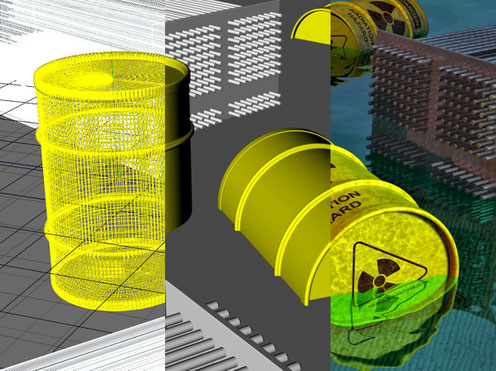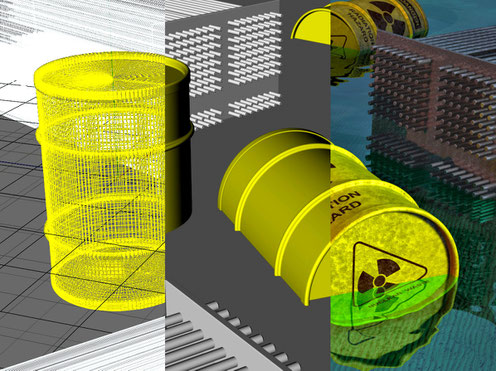Über die Grafiken
»Viele der hier gezeigten Arbeiten sind relativ spontan entstanden. Es geht in erster Linie um die grafische Umsetzung einer
Bildidee – weniger um detailreichen Realismus. Durch die Schlichtheit konzentriert sich der Blick auf das Wesentliche.« Philipp Langer, 2010
HERSTELLUNG
3D-Modeling (digitaler Modellbau / Computer-Aided Design), elektronische Bildbearbeitung (Post Processing) sowie reale Fotografie (Texturen, Hintergründe).
3D-MODELING
Computergestützte Entwicklung mittels 3D-Grafikprogramm von Szenen, Objekten und Gebäuden als Gitterdraht- bzw. Flächenmodell. Belegung der Oberflächen mit (synthetischen oder fotografischen) Texturen und Zuweisung von Materialien (Glas, Metall, Stein usw., Relief, Glanz etc.). Ausleuchtung des Modells mit verschiedenen Lichtquellen. Nach dem Modeling, Texturieren und Ausleuchten wird eine virtuelle Kamera mit einstellbarer Brennweite (z. B. Weitwinkel- oder Teleobjektiv) platziert, ausgerichtet und eine oder mehrere "Fotografien" gemacht. Der Vorgang der "Belichtung" heißt bei 3D-Grafikprogrammen Rendering (sog. Raytracing oder Photon-Mapping). Dabei simuliert das Programm den Verlauf von Lichtstrahlen von der Quelle (Leuchte), über das Objekt / die Szene, bis zum Betrachter (Kamera). Letzteres erfordert eine leistungsstarke EDV-Anlage und kann Stunden in Anspruch nehmen.
REPRODUKTIONEN
- Eine Auswahl der Grafiken wird in limitierter Auflage (Kleinserien) als großformatige Fine-Art- oder Lambda-Prints in Museumsqualität reproduziert. Kunstdrucke ohne ©-Vermerke / Wasserzeichen.
- Postkarten-Set (2015), 16 x 12 cm, mit 10 Motiven. Stabiler Chromokarton, glänzend cellophaniert.
- Umfangreicher Bilderkatalog (2013, 100 Seiten, DIN-A4), Qualitätsdruck auf Bilderdruckpapier, Spiralbindung.
- Bilderkatalog (2016, 36 Seiten, DIN-A4), Qualitätsdruck auf Bilderdruckpapier, Rückendrahtheftung.
AUFTRAGSARBEITEN
Räumliche, fotorealistische Visualisierung nach Skizze oder Fotografie. Maßstabgerechte grafische Simulationen.
Über den Künstler
- Geboren in Berlin als Sohn einer Goldschmiedin und eines Silberschmieds / Industrial Designers.
- Teilnahme an der Bürgerinitiative "Berliner Bürger gegen chemische Reinigungen".
- Entwicklung und Design von ROTADENT (elektrischer Zahnreiniger), Forschungsprojekt.
- Grundstudium Chemie / Lebensmittelchemie, Biologie, Erziehungswissenschaften an der TU Berlin.
- Studienbegleitendes, mehrjähriges Praktikum in der Werkstatt für 3-dimensionale Darstellungstechniken, FB Architektur, Hochschule der Künste Berlin. Objekte und Modelle in Metall, Holz, Stein, Kunststoff, Gips, Glas und anderen Materialien.
- Langjährige Tätigkeit als Immobilienverwalter.
- Mehrjährige Assistenz im Künstleratelier Wolfgang Schiffling, Maler, Grafiker, Bildhauer.
- Ausbildung zum staatlich geprüften Mediengestalter für Digital- und Printmedien (IHK).
- Tätig als Grafik-Designer (Printmedien, Fotografie, 3D-Grafik, Websites).
Robolotion ist das Pseudonym, unter dem Philipp Langer seine Grafiken auf diversen, nationalen und internationalen Online-Plattformen für bildende Kunst (Picasa, Flickr, deviantArt, Pinterest, Saatchi Art, facebook usw.) veröffentlicht. Eines der ersten 3D-Modelle war ein humanoider Blechroboter.
Ausstellungen
Beteiligung an öffentlichen Ausstellungen mit mechanischen Modellen und Digitalgrafiken / Kunstdrucken:
- 1997 alpha monemvasia omega, Humboldt-Universität Berlin
- 1998 Rheinländisches Industriemuseum Oberhausen
- 2000 Deutsches Zentrum für Luft- und Raumfahrt, Berlin
- 2001 Der Tod, M.A.I.S.-Projekt, Bunker unter dem Blochplatz, Berlin
- 2003 von erdmobil zu marsmobil, Lichthof der Technischen Universität Berlin
- 2009 Schrauber Goes Birding (Digital Composings), Villa Pupp, Berlin
- 2011 Beam Team Berlin VI, Kunstraum bei Streifler & Kollegen, Berlin
- 2012 robolotion graphics, Einzelausstellung in der Caffetteria Buchhandlung, Berlin
- 2013 robolotion graphics, Einzelausstellung in der Kunstkammer Friedenau, Galerie in Berlin
- 2013 Macht Kunst, Projekt der Deutsche Bank KunstHalle, Berlin, anlässlich des Berlin Gallery Weekend
- 2016 PARADOXA / la movilidad cubana, Doppelausstellung mit Thomas Rehbein (Fotografie), Kunstkammer Friedenau, Galerie in Berlin
About the graphics
»Most of the here shown works have been created relatively spontaneously. My goal is to
visualize thoughts and ideas, rather than creating perfect computer graphics that are embellished with numerous details. Due to their
simplicity the view focuses on the essentials.« Philipp Langer, 2010
PRODUCTION TECHNIQUES
Digital 3D modeling, computer-aided design, image editing (post processing) and real photography (textures, backgrounds).
3D MODELING
Computer-aided development of scenes, objects and buildings in the form of wire frame models, created with a 3D graphic program. The sculpting is followed by coating of the surfaces with
artificial or photographic textures and determination of materials such as glass, metal, stone, including shine, reflectivity, refractive index etc. Lighting of the model with various light
sources. After the modeling, texturing and lighting a virtual camera with adjustable focal length is being placed in the scene, and one or more "photos" are being taken. In the case of 3D graphic
applications the process of "exposure" is called rendering (so-called ray tracing or photon mapping). In order to accomplish the rendering process the application simulates the passage of the
light rays, starting at the light source, then being reflected by the modelled objects and finally reaching the viewer, i.e. the scene camera. A powerful computer with a multi-core cpu is
necessary for the rendering process which can take hours.
REPRODUCTIONS
- A selection of the pictures is being reproduced as large format giclée prints in archival quality and limited editions (small series). Prints without ©-marks (watermarks).
- Postcard set (2015), 6.3 x 4.7 inches, with 10 image motifs. Heavy cardstock, glossy lamination outside.
- Comprehensive graphic catalogue (2013, 100 pages, approx. 12 x 8 inches), quality print on coated paper.
- Image brochure (2016, 36 pages, approx. 12 x 8 inches), quality print on coated paper.
COMMISSIONAL WORKS
Photorealistic 3D visualization from sketches or photos. True to scale graphic simulations.
About the artist
- Design and construction of an electric toothbrush, named ROTADENT
- Studies of chemistry and biology, Technical University, Berlin
- Several years of real estate management
- Long-term work experience in a model-making workshop, University of Visual Arts, Berlin. Design and production of mechanical models made of various materials.
- Media assistant at the studio of German painter, sculptor and concept artist Wolfgang Schiffling
- Studies of media design (digital/print)
- Working as a graphic designer in Berlin, Germany
Robolotion is the nickname under which Philipp Langer publishes his graphics on various national and international online platforms for Visual Arts (Picasa, Flickr, deviantArt,
Pinterest, Saatchi art, facebook, etc.). One of the first 3D models sculpted was a manlike metal robot.
Expositions
Participation in public expositions with mechanical models and digital graphics (giclée prints).
- 1997 alpha monemvasia omega, Humboldt University of Berlin
- 1998 Rhineland Industrial Museum in Oberhausen
- 2000 German Center for Aerospace, Berlin-Adlershof
- 2001 The Death, art project M.A.I.S., Wedding Bunker, Berlin
- 2003 from earth mobile to mars mobile, Technical University of Berlin
- 2009 Beam Team Berlin V, studio exhibition, Villa Pupp, Berlin-Wannsee
- 2011 Beam Team Berlin VI, art room Streifler & Colleagues, Berlin
- 2012 robolotion graphics, solo exposition, Caffetteria Buchhandlung, artist's café, Berlin-Mitte
- 2013 robolotion graphics, solo exposition, Kunstkammer Friedenau, art gallery in Berlin
- 2013 Macht Kunst, Deutsche Bank KunstHalle, Berlin-Mitte
- 2016 PARADOXA / la movilidad cubana, double exposition with Thomas Rehbein (Photography), Kunstkammer Friedenau, art gallery in Berlin

